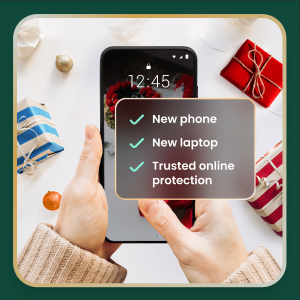Scammers aren’t worried about ending up on the naughty list. If anything, they’re doubling down in 2025.
This year, scammers are impersonating major brands with startling accuracy, from fake delivery updates to cloned checkout pages.
Our McAfee Labs researchers analyzed real scam texts, emails, and URLs from October through early November, along with consumer survey data, to identify the patterns shaping this season’s fraud.
Here’s what shoppers need to know, what’s trending upward, and how to spot the fakes before they reach your cart.
What Is a Holiday Brand-Impersonation Scam?
A brand-impersonation scam is when criminals copy a real brand, like a retailer, tech company, bank, or delivery service, to make fake emails, texts, ads, or websites that look legitimate.
Their goal is to trick shoppers into clicking, entering account details, or making a payment.
McAfee Labs’ brand impersonation analysis shows criminals focusing on the items people shop for most — tech gifts, luxury goods, and high-demand drops.
Fake versions of these brands typically include:
- Copied product photos
- Familiar layouts
- Holiday sale graphics
- Support pages designed to capture logins

Which Brands Are Being Faked the Most This Holiday Season?
Top 5 most impersonated luxury brands
- Coach
- Dior
- Ralph Lauren
- Rolex
- Gucci
Top 5 most impersonated mainstream consumer brands
- Apple
- Nintendo
- Samsung
- Disney
- Steam
Other Key Research Takeaways US:
- Email scams are exploding, up ~50% in retail and ~85% in tech as the holidays approach.
- Fake storefronts are rising, with technology URL scams up nearly 50% and consumer URL scams up ~5%.
- Trusted brands are the most impersonated, including Amazon, Microsoft, Apple, Walmart, and Costco.
- 96% plan to shop online
- 91% see ads from unfamiliar retailers
- 37% may buy from brands they don’t recognize
- AI is reshaping scams, with 46% of Americans encountering fake celebrity or influencer endorsements.
Other Key Research Takeaways UK:
- 97% plan to shop online
- 86% see ads from unfamiliar retailers
- 30% may buy from brands they don’t recognize
- AI is reshaping scams, with 42% of Americans encountering fake celebrity or influencer endorsements.
How to Stay Safe While Brands Are Being Faked This Season
Scammers are getting better at copying the brands you trust, but avoiding the fakes gets much easier when you slow down, verify what you see, and use tools that check links and messages before you click.
Here’s what actually helps during a season when realistic-looking scams are everywhere:
1. Go straight to the source
If you get a message about an order, refund, delivery issue, or account lockout, don’t click the link.
Go directly to the retailer’s app or type the URL manually.
This single habit eliminates most holiday scams.

2. Inspect the sender, not the graphics
Scammers can recreate logos, colors, and templates perfectly.
What they can’t easily mimic:
- A legitimate domain
- A verified phone number
- A support email that matches the company’s format
If the sender looks off, the message is off.
3. Let security tools check the link for you
McAfee’s online protection adds a critical layer of holiday safety, especially when scammers imitate retailers with near-perfect accuracy.
Key protections include:
Web Protection
Blocks malicious or suspicious websites before they load — including fake checkout pages, login portals, and support sites.
Scam Detector
Built into all core McAfee plans. It flags scam texts, emails, and even deepfake-style video promotions, letting you know a link or message is unsafe before you interact with it.
Password Manager
Creates and stores strong, unique passwords so a stolen login from one retailer doesn’t unlock your whole digital life.
Identity & Financial Monitoring
Transaction Monitoring and Credit Monitoring can alert you to unusual activity — a crucial safety net when stolen logins, card numbers, or personal details circulate quickly during the holidays.
These tools help counter the exact tactics scammers rely on: cloned websites, fake brand emails, and phishing links disguised as legitimate retailers.

4. Turn on two-factor authentication everywhere you shop
Even if a scammer gets your password, they can’t get in without your one-time code.
5. Treat urgency as a red flag
Legitimate companies don’t ask you to “act in minutes,” pay fees to “unlock” an account, or claim you must stay on the line.
Pressure is a tactic — not customer service.
6. Keep an eye on your accounts
Check your banking and shopping accounts weekly.
Small unauthorized charges often appear before large ones.













